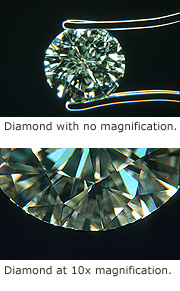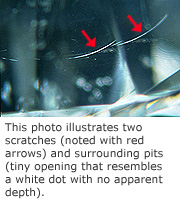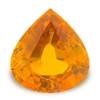Glittering Stones » About Diamond » Clarity
Clarity

 In diamonds, clarity refers to absence of inclusions and blemishes. Since diamonds occurs deep under the surface, most diamonds contains unique birthmarks called (internal) inclusions and (external) blemishes. Diamonds without birthmarks are rare and its rarity affects the value. GIA’s International Diamond Grading System has developed a clarity grade for diamond that ranges from flawless (FL) to diamond with obvious inclusions (I3). Every
diamond is unique and none is absolutely perfect under 10 x magnification. GIA Clarity Scale contains 11 grades with diamonds falling into VS (very slightly included) or SI (slightly included) categories. To determine diamond clarity grade, the GIA system consider the size, nature, position, color or relief and quantity of clarity characteristics visible under 10 x magnification.
In diamonds, clarity refers to absence of inclusions and blemishes. Since diamonds occurs deep under the surface, most diamonds contains unique birthmarks called (internal) inclusions and (external) blemishes. Diamonds without birthmarks are rare and its rarity affects the value. GIA’s International Diamond Grading System has developed a clarity grade for diamond that ranges from flawless (FL) to diamond with obvious inclusions (I3). Every
diamond is unique and none is absolutely perfect under 10 x magnification. GIA Clarity Scale contains 11 grades with diamonds falling into VS (very slightly included) or SI (slightly included) categories. To determine diamond clarity grade, the GIA system consider the size, nature, position, color or relief and quantity of clarity characteristics visible under 10 x magnification.
Clarity grading considerations
When viewed from above at 10x magnification, all grades reflect the appearance to an experienced grader, though higher magnifications and viewing from other angles are used during the grading process. The internal characteristics of diamond were studied by grader and judges them on the basis of five clarity factors: size, number, position, nature, and color or relief. The clarity grade is evaluated on the basis of the most noticeable inclusions is called "grade setting inclusions". Less significant inclusions were ignored for the purposes of setting the grade; however, they may still be plotted onto a diamond plot chart.
Size
The Size is the first clarity factor which is evaluate by the clarity characteristic's size. Under magnification, large characteristics are typically more noticeable thereby placing the diamond into a lower clarity grade.
Number
The number is the second clarity factor which is evaluated by the number of clarity characteristics. Generally, the lower the clarity grade has the more characteristics. This assessment is made by judging how easily it can be seen, not by the correct number of characteristics.
Position
The position is third clarity factor which is evaluated by the characteristic's position. Under the table of the diamond,,,the inclusion is most visible. An inclusion under the table is placed close to a pavilion facet. It will reflect multiple times around the stone, giving this type of inclusion the name as "reflector". Reflectors are graded for each reflection there is an inclusion ,plotting the diamond it is only plotted once. For this reason, reflectors have great impact on the clarity grade. When they are positioned under the crown facets, Inclusions become less visible. Inclusions were judged to pose at least a moderate risk of breakage to the stone that are graded in the Included category.
Nature
The nature is the fourth clarity factor which is evaluated by the characteristic's nature. The characteristic's nature tells about the internal (extending into the stone) or external (limited to the surface of the stone). Flawless and Internally Flawless categories were automatically excluded by the internal characteristics. Flawless category were excluded by the diamond of external characteristics. The internal characteristic of a diamond can be classified as bruise, cavity, chip, cleavage, cloud, crystal, feather, grain center, indented natural, internal graining, knot, laser drill hole, needle, pinpoint, or twinning wisp. The external characteristic of a diamond can be classified as abrasion, natural, nick, pit, polish lines, polish mark, scratch, surface graining, or extra facet.
Color or relief
The color or relief is the fifth clarity factor which is evaluated by the color and relief of clarity characteristics. Characteristics that contrast with the surrounding diamond are said to have "relief". The clarity grade of the diamond is affected when the degree to which its color and relief is noticeable. .Colored inclusions always showing the contrast and it can easily be seen. There is an exception,that black pinpoint inclusion, is more difficult to see the white pinpoint.

Flawless (FL)
No inclusions or blemishes visible to skilled grader using 10 x magnification
Internally flawless (IF)
No inclusions and only blemishes visible to skilled grader using 10 x magnification
Very, Very Slightly included (VVS1 and VVS2)

Inclusions are difficult for skilled grader to see under 10 x magnification
Very Slightly Included (VS1 and VS2)
Inclusions are clearly visible under 10 x magnification, but can be characterized as minor
Slightly Included (SI1 and SI2)
Inclusions are noticeable to skilled grader using 10 x magnification
Included (I1, I2, and I3)
Inclusions are obvious under 10 x magnification and it may affect transparency and brilliance
|
|
NOVEMBER BIRTHSTONE - CITRINE

COMMEMORATIVE EVENT - 13th Anniversary
KEYWORDS - Success, Abundance, Personal Power
ALSO KNOWN AS - Merchant's stone, Success stone
COLORS - Pale yellow to brown
OCCURRENCE - Brazil
COLOR ZONING - Tiger stripes or Zebra stripes



